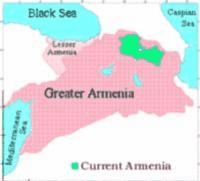
|
|
Tell a friend Bookmark Us Contact Us
Bride from Sebastia (Sepastia).Source: "Armenian Costumes" Album of the Academy of Sciences of Armenia. (National Gallery at Yerevan)

* From the earliest times, Armenia has been one of the most important centres of
metalworking in Asia Minor and the Transcaucasus. Four thousand years ago
historic Armenia was a metalworking centre excelling in gold, silver, copper
and iron. The metal objects obtained from the excavations at Lchashen, Armavir,
Metzamor, Karmir Blur, Sisian, Dvin and Ani are witnesses of a high standard of
metalworking. Vaspurakan, and specially Van - Cilicia, Sebastia (Sepastia), Caeseria, Kareen,
Shirak, Sunik, Artsakh, and the Plain of Ararat were centres for the artistic
treatment of metal and the production of ornaments and utensils.
* Carpet art is the most loved and widespread phenomenon with stable fraditions in
Armenian life from ancient times. Carpets have been woven as far back as before
Christ's birth. The historian Herodotus (485 - 425 B. C.) informs us that "the
inhabitants of the Caucasus dyed the wool with a number of plants having dyeing
qualities and they used it to make woven fabrics covered with drawings which never
lose their brilliant color... ". Dvin, Ani, Kareen, Kesaria, Sebastia (Sepastia), towns and
settlemants in Vaspourakan, Tapon, Goghtan, Syunik and other provinaea were
outsfanding centres of the Armenian carpet. Marco Polo, the Italian traveller
(XIII c.) commented: "The Armenians and Greeks in the three major towns of
Konya (lkonio), Kaiseri (Kesaria) and Sivas (Sebastia (Sepastia)) made the most beautiful
and finest rugs". The Armenians of those three towns had been deported in the
first half of the XI century from Vaspurakan, Ani, Kars. Kareen, Dvin, Ani,
Kesaria, Sebastia (Sepastia), towns and settlemants in Vaspourakan, Tapon, Goghtan,
Syunik and other provinaea were outstanding centres of the Armenian carpet.

HISTORY